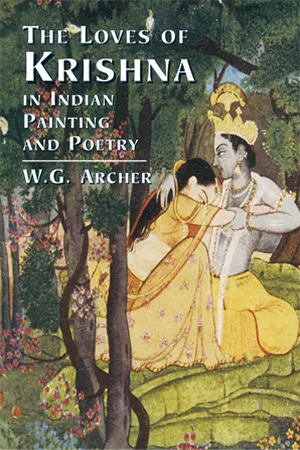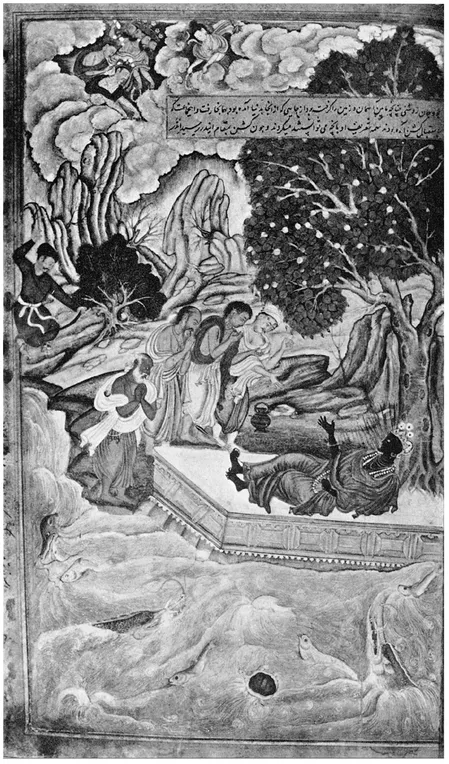
- 192 pages
- English
- ePUB (mobile friendly)
- Available on iOS & Android
eBook - ePub
The Loves of Krishna in Indian Painting and Poetry
About this book
The first book in English to provide a full and clear introduction to the imagery and verse related to one of the most significant of Indian gods. Archer's history of the depiction of Krishna's life and deeds traces the god's many aspects, from warrior to cowherd to prince. 39 plates of illustrations follow.
Frequently asked questions
Yes, you can cancel anytime from the Subscription tab in your account settings on the Perlego website. Your subscription will stay active until the end of your current billing period. Learn how to cancel your subscription.
At the moment all of our mobile-responsive ePub books are available to download via the app. Most of our PDFs are also available to download and we're working on making the final remaining ones downloadable now. Learn more here.
Perlego offers two plans: Essential and Complete
- Essential is ideal for learners and professionals who enjoy exploring a wide range of subjects. Access the Essential Library with 800,000+ trusted titles and best-sellers across business, personal growth, and the humanities. Includes unlimited reading time and Standard Read Aloud voice.
- Complete: Perfect for advanced learners and researchers needing full, unrestricted access. Unlock 1.4M+ books across hundreds of subjects, including academic and specialized titles. The Complete Plan also includes advanced features like Premium Read Aloud and Research Assistant.
We are an online textbook subscription service, where you can get access to an entire online library for less than the price of a single book per month. With over 1 million books across 1000+ topics, we’ve got you covered! Learn more here.
Look out for the read-aloud symbol on your next book to see if you can listen to it. The read-aloud tool reads text aloud for you, highlighting the text as it is being read. You can pause it, speed it up and slow it down. Learn more here.
Yes! You can use the Perlego app on both iOS or Android devices to read anytime, anywhere — even offline. Perfect for commutes or when you’re on the go.
Please note we cannot support devices running on iOS 13 and Android 7 or earlier. Learn more about using the app.
Please note we cannot support devices running on iOS 13 and Android 7 or earlier. Learn more about using the app.
Yes, you can access The Loves of Krishna in Indian Painting and Poetry by W. G. Archer in PDF and/or ePUB format, as well as other popular books in Filosofía & Filosofía oriental. We have over one million books available in our catalogue for you to explore.
Information
Topic
FilosofíaSubtopic
Filosofía orientalTHE PLATES

PLATE I
The Death of Balarama
Illustration to the Persian abridgement of the
Mahabharata, the Razmnama (or Book of the Wars)
By Basawan
Mughal (Akbar period), c. 1595
Collection H.H. the Maharaja of Jaipur, Jaipur
Mahabharata, the Razmnama (or Book of the Wars)
By Basawan
Mughal (Akbar period), c. 1595
Collection H.H. the Maharaja of Jaipur, Jaipur
Although illustrations of the Hindu epic, the Mahabharata, were rarely commissioned by Hindu patrons, the gigantic text possessed a unique appeal to Indian minds and for this reason the Mughal emperor, Akbar, chose it for translation into Persian. ‘Having observed the fanatical hatred prevailing between Hindus and Muslims,’ writes his biographer, Abul Fazl, ‘and convinced that it arose only from their mutual ignorance, the enlightened monarch wished to dispel the same by rendering the books of the former accessible to the latter.’ The work of translation was begun in 1582 and was probably concluded in 1588 when Abul Fazl wrote the preface. It is unlikely, however, that the illustrations were completed before 1595.
The present picture by one of Akbar’s greatest Hindu artists illustrates the sensitive naturalism which from antecedents in Khurasan came to elegant maturity in Mughal India between 1585 and 1600. Certain details—the drapery with its shaded folds, the steeples rising in the distance—are modelled on the European Renaissance pictures which by 1580 had already reached the court. Other details such as the lithe squirrels gambolling in the tree, the rearing snakes and dense luxuriant foliage can only have been painted by an artist devoted to the Indian scene.
In subject, the picture represents what Krishna saw on his return from destroying the Yadavas at Prabhasa. Balarama, his half-brother, has gone down to the sea and has there yielded up his spirit. Sesha, the great serpent, who is part of Vishnu himself, is now issuing from the body—Balarama having been his incarnation. Snakes come to greet him while Varuna, the god of water, stands as ‘an old man of the sea’ ready to escort him to his long home.

PLATE 2
The Death of Krishna
Illustration to the Persian abridgement of the
Mahabharata, the Razmraama (or Book of the Wars)
By Mukund
Mughal (Akbar period), c. 1595
Collection H.H. the Maharaja of Jaipur, Jaipur
Mahabharata, the Razmraama (or Book of the Wars)
By Mukund
Mughal (Akbar period), c. 1595
Collection H.H. the Maharaja of Jaipur, Jaipur
Following the death of Balarama, Krishna prepares to leave the world. He sits in meditation and is shot in the sole of his right foot by Jara, a Bhil hunter—the arrow which kills him being tipped with part of the iron which has caused the destruction of the Yadavas.
The picture shows Krishna reclining on a platform of the kind still constructed in India at the base of sacred trees. An arrow transfixes his right foot while the hunter, dressed as a courtier in Mughal dress, is shown releasing the bow. In front of Krishna stand four awe-struck figures, representing the celestial sages and devotees of Vishnu who have come to attend his passing. In the sky four gods look down. To the right is Siva. Then, a little to the left, is four-headed Brahma, below him, Indra, his body spotted with a thousand eyes and finally a fourth god of uncertain identity. Around the platform surges the snarling sea as if impatiently awaiting Krishna’s death before engulfing the doomed Dwarka.
The painting is by a colleague of Basawan (Plate 1) and illustrates the same great text.

PLATE 3
The Slaughter of an Innocent
Illustration to the Bhagavata Putana
Kangra, Punjab Hills, c. 1790
J. K. Mody collection, Bombay
Kangra, Punjab Hills, c. 1790
J. K. Mody collection, Bombay
Following the expansion of Indian miniature painting in the early seventeenth century, illustrated versions of the tenth book of the Bhagavata Purana began to be produced in parts of Hindu India. It was in the Punjab Hills, at the end of the eighteenth century, however, that romance and religion achieved their most delicate expression. The artist chiefly responsible was a certain Nainsukh who had arrived at the State of Guler in about 1740. His way of painting had marked affinities with that of Basawan (Plate 1) and represents a blend of early Mughal naturalism with later Hindu sentiment. The style founded by him influenced members of his own family, including his nephew Kushala and ultimately spread to Kangra and Garhwal where it reached its greatest heights. The present picture, together with Plates 5, 6, 8, 9, 11 and 16, is possibly by the Kangra artist Purkhu and with others of the series illustrates perhaps the greatest interpretation of the Bhagavata Purana ever produced in Indian painting.
In the picture, the tyrant ruler Kansa is sleeping on a bed as a courtier prepares to break the fateful news of Krishna’s birth. To the right, Devaki, Krishna’s mother, nurses the baby girl whom her husband, Vasudeva, has substituted for the infant Krishna. Kansa is wresting the baby from her in order to dash its head against a boulder. As he does so, she eludes his grasp and ascends to heaven in a flash, being, in fact, the eight-armed goddess Devi.

PLATE 4
Krishna stealing Butter
Illustration to an incident from the Bhagavata Purana
Basohli, Punjab Hills, c. 1700
N. C. Mehta collection, Bombay
Basohli, Punjab Hills, c. 1700
N. C. Mehta collection, Bombay
Besides illustrating the tenth book of the Bhagavata Purana as a whole, Indian artists sometimes chose isolated episodes and composed their pictures around them. The present picture is an instance of this practice, its subject being the baby Krishna pilfering butter. As Yasoda, Krishna’s foster-mother, goes inside the house, Krishna and the cowherd children stage an impudent raid. A cowherd boy mounts a wooden mortar and then, balanced on his shoulders, the young Krishna helps himself to the butter which is kept stored in a pot suspended by strings from the roof. A second cowherd boy reaches up to lift the butter down while edging in from the right, a monkey, emblematic of mischievous thieving, shares in the spoil.
The picture illustrates the wild and vehemently expressive style of painting which suddenly appeared at Basohli, a tiny State in the Punjab Hills, towards the end of the seventeenth century. The jagged form of Yasoda, cut in two by the lintel of the doorway, the stabbing lines of the churning pole, grazing sticks and cords, as well as the sharp angles of the house and its furniture, all contribute to a state of taut excitement.

PLATE 5
The Felling of the Trees
Illustration to the Bhagavata Purana
Kangra, Punjab Hills, c. 1790
State Museum, Lucknow
Kangra, Punjab Hills, c. 1790
State Museum, Lucknow
From the same great series as Plate 3, here attributed to the Kangra artist Purkhu.
The young Krishna, tied to a mortar to keep him out of mischief, has dragged it between two trees and thereby uprooted them. The cowherds, led by the bearded Nanda, Krishna’s foster-father, have hurried to ...
Table of contents
- Title Page
- Copyright Page
- Dedication
- ACKNOWLEDGMENTS
- Table of Contents
- I - INTRODUCTION
- II - THE MAHABHARATA: KRISHNA THE HERO
- III - THE BHAGAVATA PURANA : THE COWHERD
- IV - THE BHAGAVATA PURANA: THE PRINCE
- V - THE KRISHNA OF POETRY
- VI - THE KRISHNA OF PAINTING
- NOTES
- BIBLIOGRAPHY
- INDEX
- THE PLATES
- SOURCES